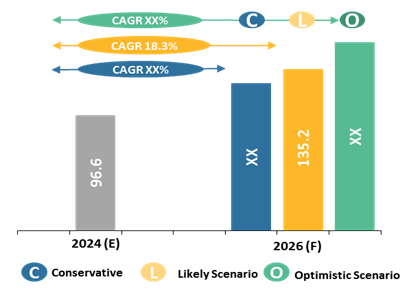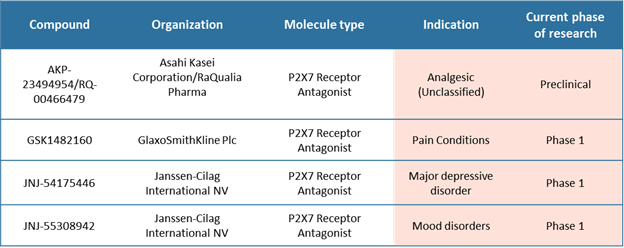P2X7 Receptor Antagonist Market Insights
The P2X7 receptor is an ATP-gated, non-selective cation channel that has been linked to a number of inflammatory diseases. Activation of the P2X7 receptor by elevated levels of adenosine triphosphate (ATP) results in the release of pro-inflammatory cytokines and elevated levels of these cytokines has been associated with a variety of disease states. So, P2X7 receptor antagonists can be viable therapeutic agents, which is why leading manufacturers such as GlaxoSmithKline Plc., Johnson & Johnson, AstraZeneca Plc., and other manufacturers such as RaQualia Pharma, Evotec AG, and Asahi Kasei Corporation are working towards development of P2X7 receptor antagonist. Currently, there is no P2X7 receptor antagonist available in the market, and not a single P2X7 receptor antagonist in late stages of clinical trials. Therefore, manufacturers are competing on the same level with respect to the P2X7 receptor antagonist development. The category has a lucrative opportunity if a drug is introduced into the market, provided a drug successfully completes clinical trials. First mover to complete clinical trials, (and first to launch) will be able to gain significant share in the market, as healthcare systems always demand new medicines. Currently, opioid medications are heavily used for pain management and are highly addictive. Therefore, approval and launch of a non-addictive pain management option is expected to be a breakthrough in this product space.
Potential of P2X7 receptor antagonists in treatment of various diseases is expected to drive the global P2X7 receptor antagonist market growth over the forecast period
Various research studies reported activation of P2X7 channels due to release of pro-inflammatory cytokines IL-1b and IL-18. As adenosine triphosphate (ATP) has lowest affinity for P2X7 among all other purinergic ion channels (P2X4, P2X3, and others), extracellular ATP rarely activates P2X7 channel. P2X7 receptor antagonists have significant therapeutic potential, as P2X7 receptors have been found to be associated with regulation of inflammation, and all immune cell types (lymphocytes, macrophages, monocytes, and others) express P2X7R. Moreover, P2X7 ion channel has been directly linked to major depression and animal studies have shown that antagonism of P2X7 with centrally penetrant antagonists resulted in antidepressant-like behavior in animal models. Therefore, inflammation, pain indications, mood disorders, and depression are the potential areas among others where, P2X7 is involved, and its antagonism can modify disease outcomes, or can be a disease-modifying therapy. As such, P2X7 is an ideal drug target as antagonism of P2X7 channel would not cause any serious side effects, as antagonism will only start when the channel is activated by high ATP concentrations, believed to happen during pathology of neuroinflammatory disorders of the Central Nervous System (CNS) such as stroke, epilepsy, multiple sclerosis, chronic neurodegenerative, and neuropsychiatric diseases. These factors are expected to support global P2X7 receptor antagonist market growth over the forecast period.
The global P2X7 receptor antagonist market size is expected to be valued at US$ 135.2 million by 2026, and is projected to exhibit a CAGR of 18.3% over the forecast period.
Figure No.1: Global P2X7 Receptor Antagonist Market Scenario 
To learn more about this report, Download Free Sample
Source: Coherent Market Insights Analysis (2019)
Robust early stage pipeline is expected to support the global P2X7 receptor antagonist market growth over the forecast period
Manufacturers such as GlaxoSmithKline Plc, Johnson and Johnson, AstraZeneca plc, Asahi Kasei Corporation, and others have potential molecules in the pipeline.
Asahi Kasei Corporation, AstraZeneca Plc, and RaQualia Pharma Inc. have their products in preclinical stages for various indications such as analgesics, inflammation, and other indications.
GlaxoSmithKline Plc, Johnson & Johnson, and Evotec AG have these molecule for indications such as pain conditions, inflammatory conditions, major depressive disorder, and mood disorders.
Although, these molecules are in early stages of development, and faster clinical trials and active interest by companies such as Evotec AG, and Asahi Kasei Pharma to advance the pipeline is expected to support growth of the global P2X7 receptor antagonists market over the forecast period.
Figure No.2: Global P2X7 Receptor Antagonist Market Pipeline Scenario

To learn more about this report, Download Free Sample
However, leading international manufacturers such as GlaxoSmithKline Plc. and AstraZeneca Plc. have not been actively pursuing the advancement of P2X7 receptor antagonist category. For instance, GlaxoSmithKline Plc’s P2X7 candidate GSK1482160 is still in Phase 1 clinical trials and the study ended in April 2009. Moreover, the category has less number of candidates in the pipeline as compared to other conditions such as cancer and others. This factor has affected global P2X7 receptor antagonist market growth.
Some of the major players operating in the global P2X7 receptor antagonist market include, GlaxoSmithKline Plc, Johnson & Johnson, AstraZeneca Plc, RaQualia Pharma, Evotec AG, and Asahi Kasei Corporation.
Share
Share
Missing comfort of reading report in your local language? Find your preferred language :
Transform your Strategy with Exclusive Trending Reports :
Select a License Type
Joining thousands of companies around the world committed to making the Excellent Business Solutions.
View All Our Clients